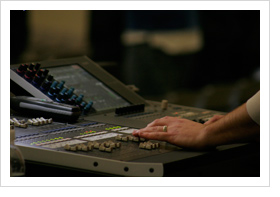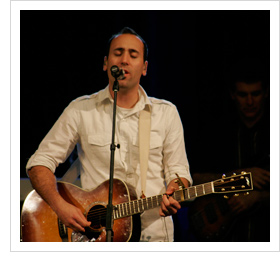Mix Sound Like a Pro. Part Seven: The Mix Pyramid!
Veteran Technical Director and CCI Solutions Church Relations Director Duke DeJong shares the seventh in a series of articles dedicated to helping you learn how to mix sound like a Pro for live worship. Join Duke on Facebook at www.facebook.com/ccisolutions & www.twitter.com/ccisolutions.
 We've spent the past 6 Worship Tools Newsletters looking at the various knobs and functions of the typical audio console, trying to de-mystify what often looks like a scary piece of equipment. I know when many new volunteers see an audio console, they get intimidated. Let's face it: we're all intimidated by the unknown. Now that we've covered the functionality and elements of the average console, it's time to transition our conversation into the actual mix itself.
We've spent the past 6 Worship Tools Newsletters looking at the various knobs and functions of the typical audio console, trying to de-mystify what often looks like a scary piece of equipment. I know when many new volunteers see an audio console, they get intimidated. Let's face it: we're all intimidated by the unknown. Now that we've covered the functionality and elements of the average console, it's time to transition our conversation into the actual mix itself.
How Do I Build a Mix!
I'm often asked about how I build a mix. It seems like such a simple question, but it often has a more complicated answer, as the answer is "it depends". It depends on what the band is trying to sound like. It depends on what the lead instrument is. It depends on what final sound the Worship Leader is trying to get. It does not depend on what kind of musical style I like. The answers to these "it depends" questions will come from your leadership (more on that in a future Worship Tools newsletter). The basic principle I use to create a good mix is explained below. Once you know what kind of sound to shoot for, you can apply this principle to build the sound your team is after.
Mix Pyramid!
 Think of your mix as a pyramid. When you come across a true wonder, especially something as big and tall as a pyramid, what's the first thing you do? Look up! At the top of the pyramid are the parts you always see. It is the lead part of the pyramid, typically the first thing you see as you approach it from a distance. It's also the narrowest part of the pyramid. As you go down the pyramid it gets bigger and bigger, but it also gets less and less defined. You start to lose the tight definition of the pyramid and see more of the entire shape as a whole. At the bottom of the pyramid you have critical components, essentially those things that hold the pyramid up and give it its base. You don't always see the absolute base of the pyramid though, as it may be under the sand.
Think of your mix as a pyramid. When you come across a true wonder, especially something as big and tall as a pyramid, what's the first thing you do? Look up! At the top of the pyramid are the parts you always see. It is the lead part of the pyramid, typically the first thing you see as you approach it from a distance. It's also the narrowest part of the pyramid. As you go down the pyramid it gets bigger and bigger, but it also gets less and less defined. You start to lose the tight definition of the pyramid and see more of the entire shape as a whole. At the bottom of the pyramid you have critical components, essentially those things that hold the pyramid up and give it its base. You don't always see the absolute base of the pyramid though, as it may be under the sand.
Applying the Theory!
What does this have to do with sound? Well, in a worship mix I believe the top of the pyramid is always the lead vocal. It should always be the first thing you hear, just as the top of the pyramid is the first thing you see as you come near. Work your way down just a little bit and usually you'll "see" the lead instrument, kick and snare. These need to be well defined in the mix as they carry the tempo and melody of the song.
Now we start getting into the mid section of the pyramid, where we start adding more size and maybe start losing just a little individual definition. The bass guitar, background vocals and the secondary lead instrument usually fit in this range. You're still going to hear them individually, but when everything is grooving well you may not hear each as clearly defined as the stuff at the top.
As you approach the base of your mix pyramid, you get to a place where you can't really hear each item all the time individually, but they make up the critical base that holds up the rest of the mix pyramid. Often, these are things like a keyboard pad, orchestration, a choir and 3rd and/or 4th guitars. These items are all just as critical as the top of the pyramid, but their size and depth provide more of a base and a big picture sound rather than individually recognizable instruments.
Keeping The Main Thing The Main Thing!
 Most every musician and singer wants to be heard. It makes sense and it's not wrong. In the overall mix of a band though, certain instruments and singers will need to take priority in clarity. Some pieces will always need to be clearly heard while others will make up the critical base that holds it all up. After all, a pyramid that only has a top won't be very big, and a pyramid with only a big bottom will have no point. It all needs to work together, each part filling it's role and place in the pyramid in order to create a wonder of beauty.
Most every musician and singer wants to be heard. It makes sense and it's not wrong. In the overall mix of a band though, certain instruments and singers will need to take priority in clarity. Some pieces will always need to be clearly heard while others will make up the critical base that holds it all up. After all, a pyramid that only has a top won't be very big, and a pyramid with only a big bottom will have no point. It all needs to work together, each part filling it's role and place in the pyramid in order to create a wonder of beauty.
Building the Mix
When sound check is done and it's time to build my mix, I look at my mix pyramid for each song (yes, it may change per song) and begin building from the top down. For my church, it often looks like this:
Lead Vocal |
Kick, Snare, Acoustic |
Background Vocals, Electric, Bass |
Toms, Cymbals, Saxophone, Piano, Violin, Keyboards |
What did you notice about this list? Did you see how it even looks like a pyramid? And the more inputs you have, the bigger your pyramid gets. Ultimately though, if you want your pyramid to have shape and definition, and if your worship mix is to have a point, some items must be at the top. In the next Worship Tools newsletter, we'll discuss how to determine your mix pyramid and who really is the architect of your pyramid.
Click to Continue Reading Part 8: Mix Pyramid - The Architect!
Read the Complete 10 Part Series Here
